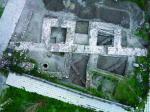Summary (English)
AGATHOPOLIS (Andrei Aladzhov – alajov@gmail.com) The explorations of the northern fortification wall, 1.85 m wide, continued. The northeastern rectangular corner tower was discovered, 5.95 m long and with walls 1.80 – 1.95 m wide. A second rectangular tower, 4 m in width and with walls 1.90 m wide, was explored at 15 m to the west of the corner tower, a third tower with identical size was discovered at 3 m to the west. These two fortification towers flanked the passage of the Northern Gate, 2 m wide and 6 m long. A pavement of slabs was explored in front of the entrance of the gate. The fortification wall was built in opus emplectum in the beginning of the 6th century AD. A gold solidus of Justin I was discovered under the mortar plaster of the floor of the first construction period giving a terminus post quem for the construction of the fortress. The numerous coins of Justinian I, Justin II and Maurice, discovered over and under the mortar plaster of the floor of the second construction period allow us to date the reconstruction of the fortress to AD 550 – 575. The latest reconstructions of the fortress dated to the end of the 14th – beginning of the 15th centuries, judging from the finds. An earlier Late Antique stratum was discovered. A wall of a burned house was discovered under the mortar plaster of the floor of the fortification gate and towers; terracotta lamps, amphorae and coins of the first half of the 5th century AD were found. The building was burned in the middle of the 5th century AD, judging by a coin of Theodosius II. Part of a building was explored inside the fortress, probably a Late Mediaeval church. Two Late Mediaeval Christian burials were discovered to the west of the building.
- Andrei Aladzhov - Archaeological Institute with Museum
Director
Team
Research Body
- Archaeological Institute with Museum






![Download [PDF]](/excavation/skins/fasti/images/results/download_sml.png)
